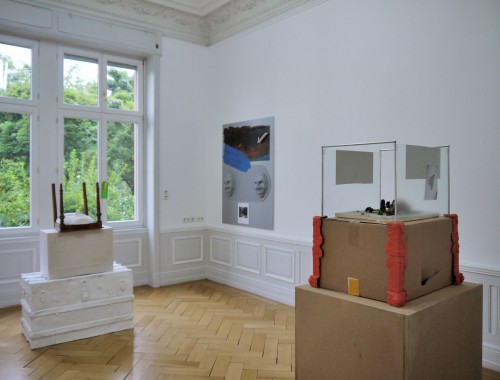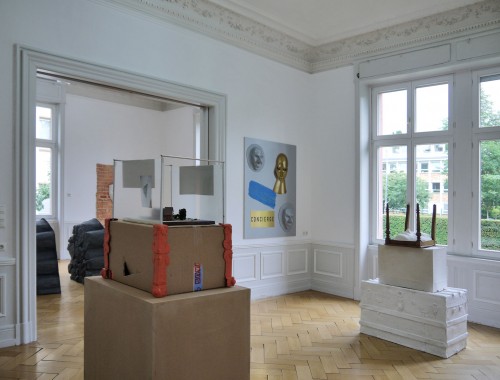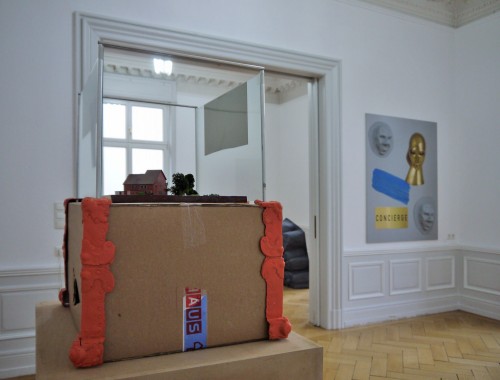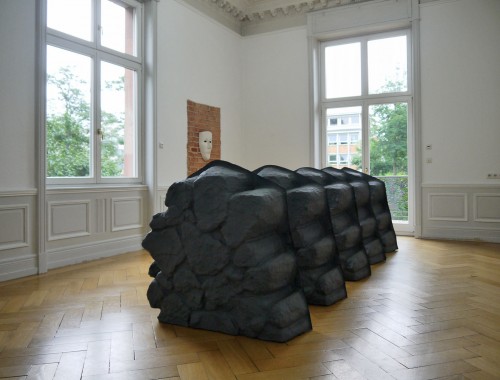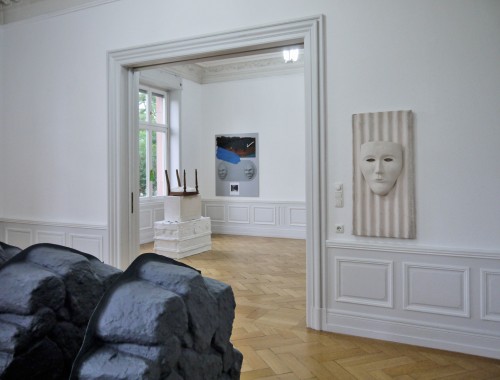Emanuel Röhss & Mateo Tannatt
THE THATCH OF THE ROOF AND/OR HOW TO DIVIDE A ROOM IN TWO
31.07. - 01.09.2017
Imagine a room that is never ending. Unlike a maze it doesn’t twirl itself inwards like a cinnamon bun, but rather unfolds with greater and greater magnitude the more you delve into it. This room does not at all evoke that unease which might transpire within labyrinths when faced with their gleaming mouths. As you peer through the doorway to its interior you feel an immense curiosity and longing for the potency of the exploration that lies ahead.
Once you find yourselves under the thatch of its roof a voyage of encounters commences. Initially, familiar milieus such as the stairs down to the basement of your parents house where, as a kid, you disguised yourself, playing hide and seek, reveal themselves. Then the stairs transform into a descending staircase and lead to a much more grandiose lounge that doesn’t at all fit together with those initial stairs. Yet this parlor seems just as familiar even though you never lived in it. Is it perhaps the entrance to the Greystone Mansion1 in Beverly Hills? Or could it be that you have arrived within a rather elaborate part of a film set? The understanding eventually prevails that this piece of architecture is a work of fiction. It brings a feeling of deja- vu. You rationally explain it to yourself as something you’ve seen before, perhaps in a film. Yet what film? You cannot tell.
The binary relation between the reality and the artificiality of one and the same built interior, which you have started to unpack on your journey inwards, is only decipherable to you via conceptions of theatricality and pretense. Hence, you start thinking of the properties that distinguish a real environment from it’s simulacrum — and you remember that it is the capacity of the latter to not be subsumed to the worldly logic of the former that eventually reveals its forged nature2. Conclusion: the stairs you have initially descended must have been simply an image of that place from your adolescence.
As you try to reconcile the experience of this perplexing dwelling you arrive at the thought of what it would be like if you were a wild animal, a beast from far away lands, who one day found a city built all around your natural habitat, enveloping your entire existence. That situation would leave you no other option but to penetrate the urban strata to find a way back to your innate surroundings3. And in the midst of this trek, after days without food, you find yourself, for the first time ever, inside a House, searching for something to nibble on. It is quite disorientating to traverse this rectilinear cave, which by smell and ambience reveals itself as someone else’s intimate nest. It is of a type that you have never stepped foot in before, yet you feel an urgent need to explore
it entirely. You stumble over objects that you lack names for: a TV, a dinner table, a bookshelf, an old chest. The appearance of you frenetically sniffing through every inch and corner of this abode resembles that of a burglar in their looking for flat screens, silverware and jewelry within the old chest, to take with them. You reminisce over CCTV footage you’ve seen online of teenagers robbing houses, navigating domestic spaces like nocturnal animals.
Perhaps what is being revealed to you on this journey through the Double Room is how the effect of a space can be as engulfing and dominant on its occupants as the journey you take through space and time when reclined in the seat of a movie theater staring at the illusory spatiality behind the screen. Because, when the images disappear, and the narrative comes to a full stop, you are left alone with little more than an echo of that room in your memory chamber, a husk, a Death Mask.




